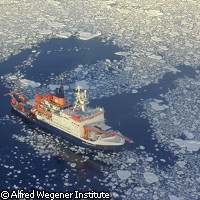Polarstern expedition uncovers deep-sea secrets of Arctic geology
The latest expedition of the German research vessel Polarstern has provided new insights into the geology of previously uncharted Arctic waters. The new data will flow into a variety of scientific projects including the major EU-funded project DAMOCLES ('Developing Arctic Modelling and Observing Capabilities for Long-term Environmental Studies'). One of the most exciting discoveries the researchers have made is that there are large sliding masses along the East Siberian continental shelf. Sliding masses are evidence of great sediment relocations which appear, for instance, when large amounts of sediment are deposited, explains Dr Wilfried Jokat, geophysicist at the Alfred Wegner Institute, the research organisation operating Polarstern. As more and more particles settle on the seafloor, the continental slope becomes instable and sediments slide down. The scientists have pinpointed the ice masses of the East-Siberian mainland as the source of these sediments. When the ice masses thawed during an interglacial period, they released their sediments into the ocean with the meltwater. 'This is a spectacular finding. Large-scale glaciations in eastern Siberia within the younger geological past of 60,000 years and older are so far unknown,' says Professor Dr Rüdiger Stein, also of the Alfred Wegener Institute. While the expedition has come to an end, the scientific work has barely begun. The research will contribute to the International Polar Year and the North Atlantic project of the German Federal Ministry of Education and Research. The researchers have brought back 16 soil samples taken during the 700 kilometre journey from the Canada Basin via the Mendeleev Ridge, which stretches from the East Siberian Sea to the central areas of the ocean, and the Makarov Basin. The analysis of these samples will for the first time make it possible to compare the glacial history of the northern USA and Canada with that of Siberia. At the same time, it will shed light on temporal and spatial changes of ocean currents and the extent of sea ice in the central Arctic Ocean. 'We expect from these investigations important new insights into the control procedures of long and short term climate changes in the Arctic,' Professor Stein adds. Further data gathered through acoustic measurements of the deep layers under the ocean floor down to a depth of 4,000 metres helps the researchers to better understand the geological development of the Arctic Ocean during the last 90 million years. 'The collected data show that the ocean basin between the two Arctic ridge systems, the Lomonossov and the Mendeleev Ridge, are considerably older than estimated so far. Thus the basins in the old part of the Arctic Ocean, the Makarov and the Canada Basin, have developed at about the same time,' says Dr Jokat. 'The following detachment of the Lomonossov Ridge from the East-Siberian Shelf took place 60 million years ago - not without massive changes to the environment. 'The data present evidence of strong relocation processes in the deep-sea sediments. Many model representations about the development of the Arctic Ocean must be rethought on the basis of the new data,' Dr Jokat concludes. The researchers onboard Polarstern were able to study some of the areas only because of the worryingly small sea ice cover, which is further evidence of the progress of global warming. This was Polarstern's 23rd expedition into the Arctic. With 47 researchers from 12 nations inside and outside the EU onboard, it travelled a distance of 10,800 nautical miles (20,000 kilometres) during this two-month trip, which lasted from 12 August to 17 October.
Countries
Germany



